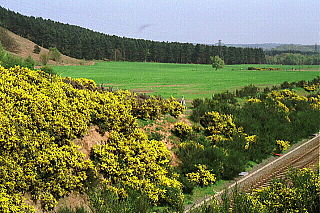
Newstead Abbey, in Nottinghamshire, England, was formerly an Augustinian priory. Converted to a domestic home following the Dissolution of the Monasteries, it is now best known as the ancestral home of Lord Byron.

Firbeck is a village and civil parish in the Metropolitan Borough of Rotherham in South Yorkshire, England, on the border with Nottinghamshire. It lies between Maltby and Oldcotes, off the A634 and B6463 roads. Firbeck had a population of 317 in 2001, which had fallen to 299 at the 2011 Census.

John Carr (1723–1807) was a prolific English architect, best known for Buxton Crescent in Derbyshire and Harewood House in West Yorkshire. Much of his work was in the Palladian style. In his day he was considered to be the leading architect in the north of England.
Colwick is a village, civil parish, in the Borough of Gedling in Nottinghamshire, England. It is situated to the east of Nottingham's city boundary, and forms the Colwick ward. At the time of the 2011 census, the village had a population of 2,829.

Annesley is a village and civil parish in the Ashfield district of Nottinghamshire, England, between Hucknall and Kirkby-in-Ashfield. At the 2011 census, it had a population of 1,162.

Annesley Hall is a Grade II listed country house near Annesley in Nottinghamshire, England and the ancestral home of the Chaworth-Musters family. The 13th-century park, 17th-century terraces and 19th-century pleasure gardens and walled gardens of the hall are Grade II* listed on the Register of Historic Parks and Gardens.

Worksop Manor is a Grade I listed 18th-century country house in Bassetlaw, Nottinghamshire. It stands in one of the four contiguous estates in the Dukeries area of Nottinghamshire. Traditionally, the Lord of the Manor of Worksop may assist a British monarch at his or her coronation by providing a glove and putting it on the monarch's right hand and supporting his or her right arm. Worksop Manor was the seat of the ancient Lords of Worksop.

Sir John Byron was an Elizabethan English nobleman, landowner, politician, and knight. He was also known as Little Sir John with the Great Beard.
Emanuel Scrope, 1st Earl of Sunderland, 11th Baron Scrope of Bolton was an English nobleman. He was Lord President of the King's Council in the North.

Serlby Hall is a grade I listed 18th century mansion and estate in Nottinghamshire, England, located 7 miles north-east of Worksop.
The Sheriff of Nottinghamshire, Derbyshire and the Royal Forests is a position established by the Normans in England.

George Gordon Byron, 6th Baron Byron of Rochdale, better known as the poet Lord Byron, was born 22 January 1788 in Holles Street, London, England, and from 2 years old raised by his mother in Aberdeen, Scotland before moving back to England aged 10. His life was complicated by his father, who died deep in debt when he was a child. He was able to work his way through school, and his life advanced after he inherited both his great-uncle's title in 1798 and the Newstead Abbey estate.

Langar Hall is a Grade II listed house, now a hotel, next to the church in Langar, Nottinghamshire.

Wiverton Hall is an English country house near Tithby, Nottinghamshire. By 1510 the former village of Wyverton had become impoverished and reduced to just four houses and a cottage. It was in that year completely depopulated by "emparkment", when George Chaworth enlarged his park by 254 acres. All but the Grade II* listed gatehouse of the mansion was destroyed in the English Civil War. The current house dates from 1814.
Sir Thomas Chaworth was an English landowner and Member of Parliament. He and his second wife, Isabel Chaworth, became one of the richest family's in England when his wife unexpectantly inherited the estate of Hugh Aylesbury of Milton Keynes.
William Musters Chaworth Musters was an English cricketer who was associated with Oxford University Cricket Club and made his first-class debut in 1829. He also played for Nottinghamshire.

Felley Priory is a 16th century house with gardens located in the village of Felley, Nottinghamshire, UK. It is situated on the grounds of a former priory established by Augustinians in 1156 and dissolved in 1536. The gardens were started in 1974 by Maria Chaworth-Musters and opened to the public through the National Garden Scheme just two years later. Since Maria's passing in 2010, the gardens have been managed by her granddaughter and expert gardener, Michelle Upchurch. In 2021, the gardens were one of the four finalists in the public gardens category in NGS's The Nation's Favourite Gardens competition.

George Chaworth Musters (1841–1879) was a British Royal Navy commander and traveller, known as the "King of Patagonia".

High Marnham is a village within the Marnham civil parish in Bassetlaw district, of the county of Nottinghamshire, England. It is 120 miles north of London, 23 miles north east of the city of Nottingham, and 17 miles north east of the market town of Mansfield. There is one listed building in the village.
















